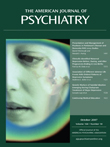To The Editor: We thank Dr. Trainor for her thoughtful letter regarding the treatment of trichotillomania in children and adolescents. Dr. Trainor suggests that CBT incorporating habit-reversal therapy rather than medication should be used as a first-line treatment for young people.
To our knowledge, there have been no controlled treatment trials (psychological or pharmacological) in childhood or adolescent trichotillomania
(1) . Our review of available treatment trials in adults with trichotillomania revealed a superiority of CBT relative to waiting-list comparison or pill-placebo. However, treatment studies were typically conducted in academic research settings not representative of most outpatient clinics and did not control for nonspecific therapeutic factors such as time spent with the practitioner. Pharmacological studies we identified were few, with small sample sizes and limited power to detect treatment effects. There was some evidence to support treatment with the serotonin reuptake inhibitors (SRIs) clomipramine or citalopram. As noted in our review, it is difficult to generate treatment algorithms on the basis of such a limited evidence base.
We concur with Dr. Trainor regarding the need for careful screening. Comorbid depression in trichotillomania is likely to interfere with habit reversal, since it requires substantial patient motivation. Consideration of pharmacotherapy in the presence of comorbid depression in young people requires caution. In children with depression, SSRIs have been linked to increased suicidality and suicidal thoughts. There is ongoing debate regarding the risk/benefit ratio in this group, with some studies suggesting an unfavorable balance and others suggesting that these drugs should retain a treatment role
(2,
3) . SSRIs appear to be effective and well-tolerated in the treatment of childhood obsessive-compulsive disorder (OCD), and several (sertraline and fluvoxamine [
4,
5 ]) are licensed for this purpose in the United Kingdom.
In addition to efficacy and safety, patient preference, treatment availability, and the deleterious consequences of
not intervening in a timely fashion need to be taken into consideration
(6) . For adults with trichotillomania, pharmacotherapy may be preferred over CBT incorporating habit reversal. SRIs are widely available and are relatively inexpensive to administer, while tailored CBT (especially incorporating habit reversal) is not widely available. In adults, concurrent OCD or depression would further favor intervention with an SRI (e.g., clomipramine or citalopram)
(7) . For children and adolescents with trichotillomania, greater caution over the use of pharmacotherapy is required. SRI treatment in youth should be carried out in close consultation with the patient and his or her parents or guardians, with regular monitoring and screening for suicidal ideas or behaviors.
Dr. Trainor raises important diagnostic issues, since many patients do not endorse the strict DSM-IV criteria related to growing tension before hair pulling and subsequent relief. Rather, hair pulling is often undertaken during relaxation or in a habitual and dissociative fashion. A broader conceptualization of trichotillomania, recognizing the role of affect dysregulation, behavioral addiction/compulsivity, and impaired top-down cognitive control has been suggested
(8) . Such a conceptualization may inform amendment of the diagnostic criteria for trichotillomania in any forthcoming classificatory revision.

